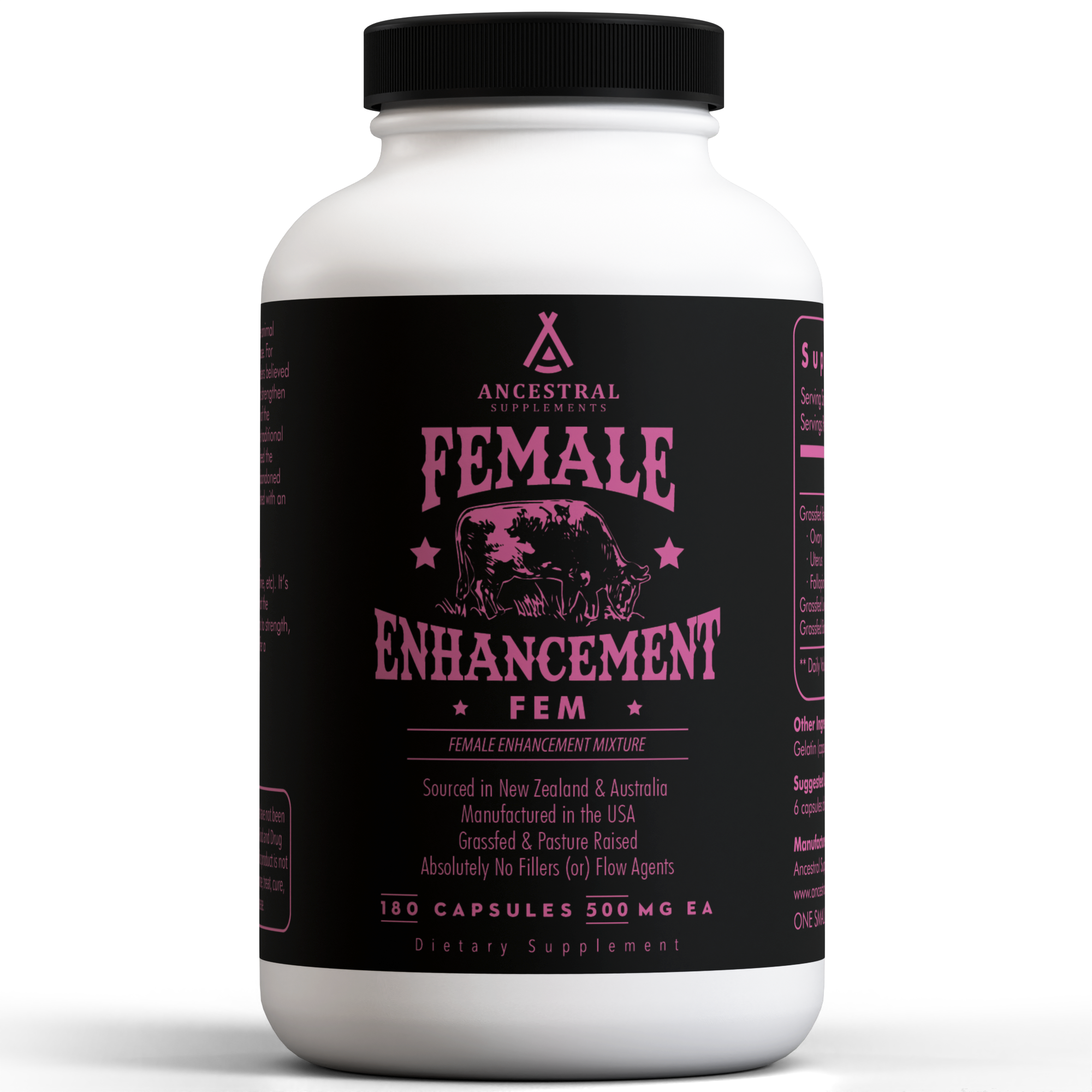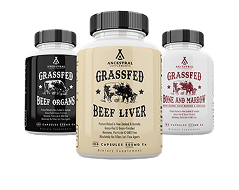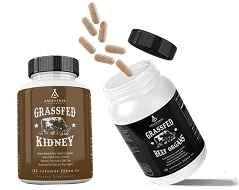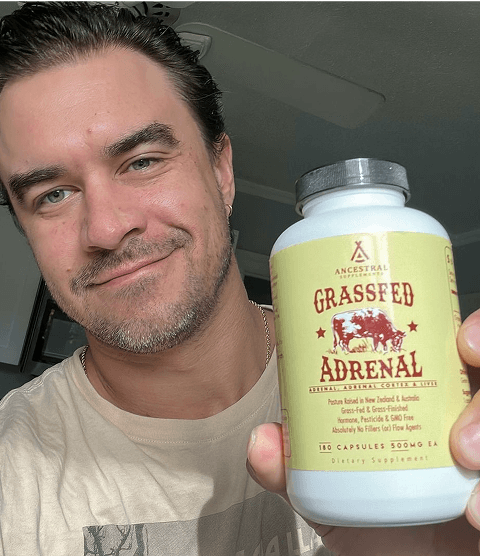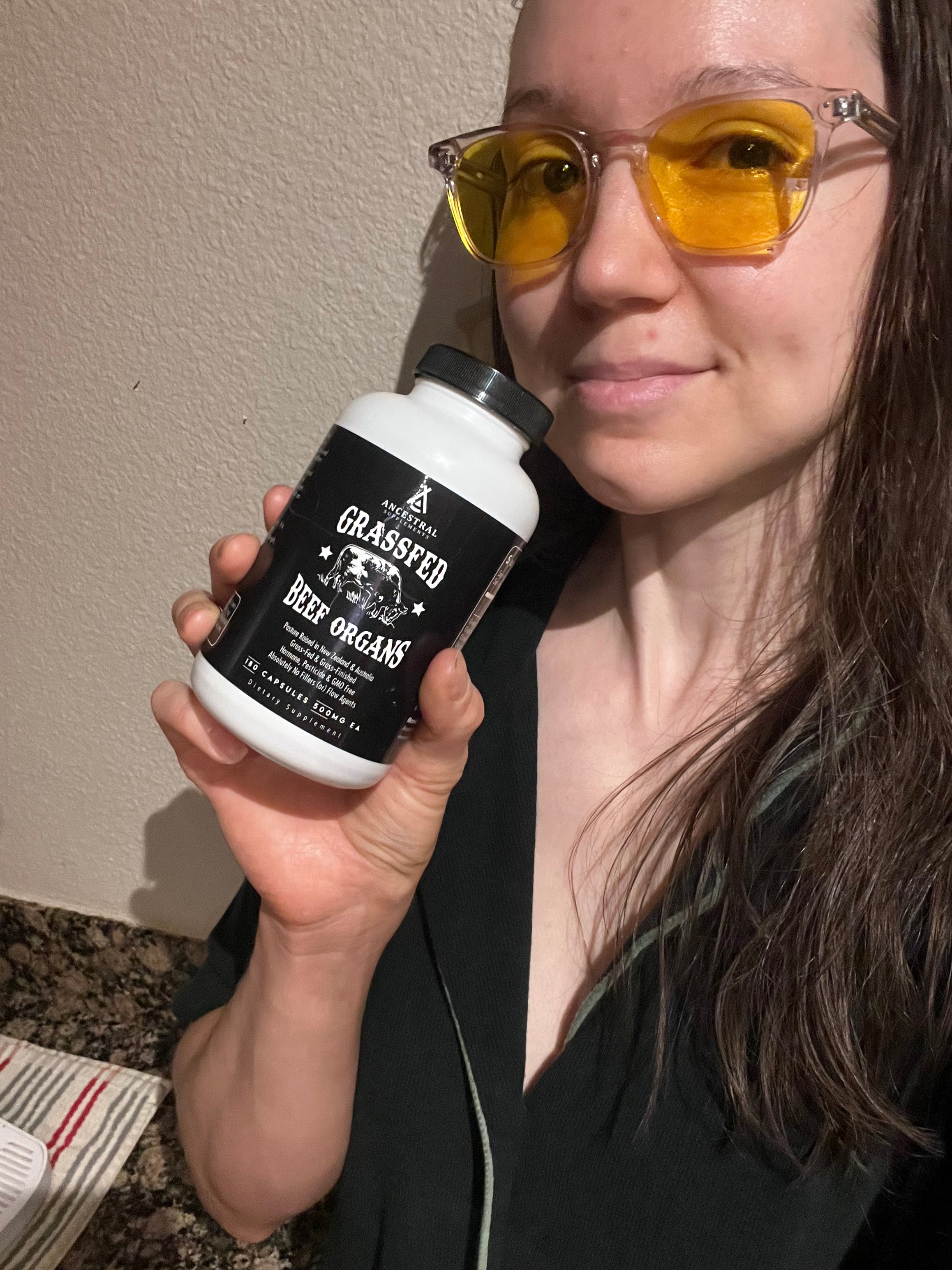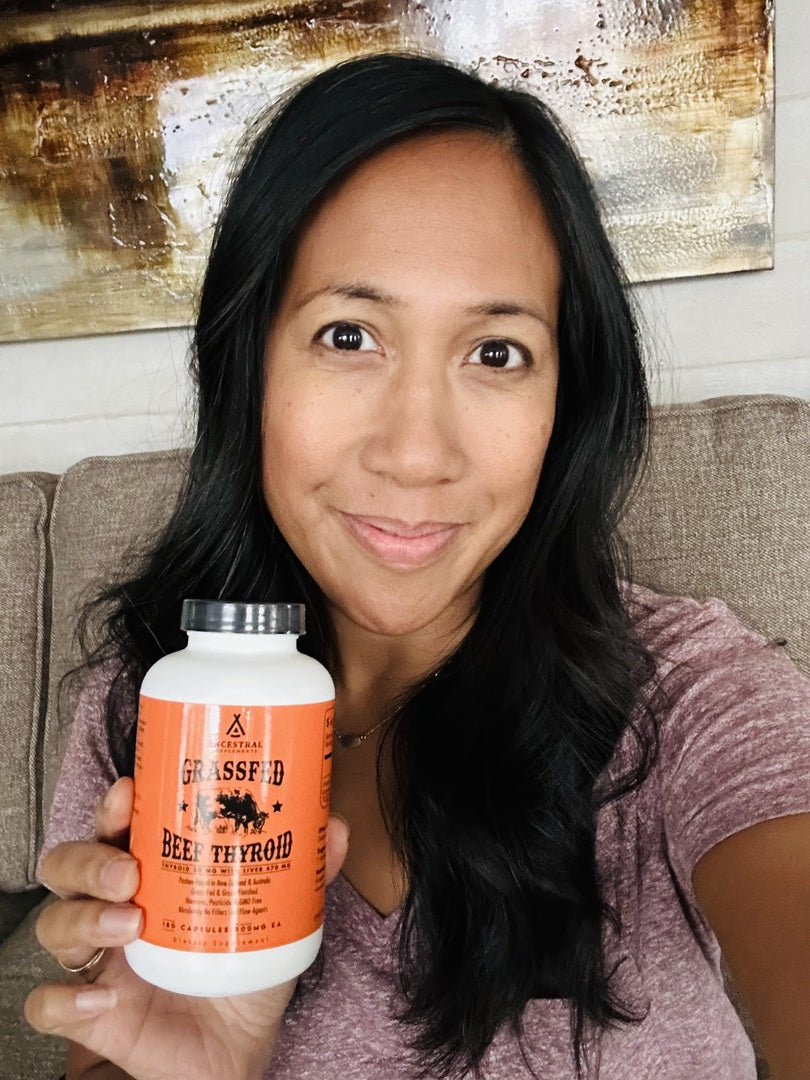






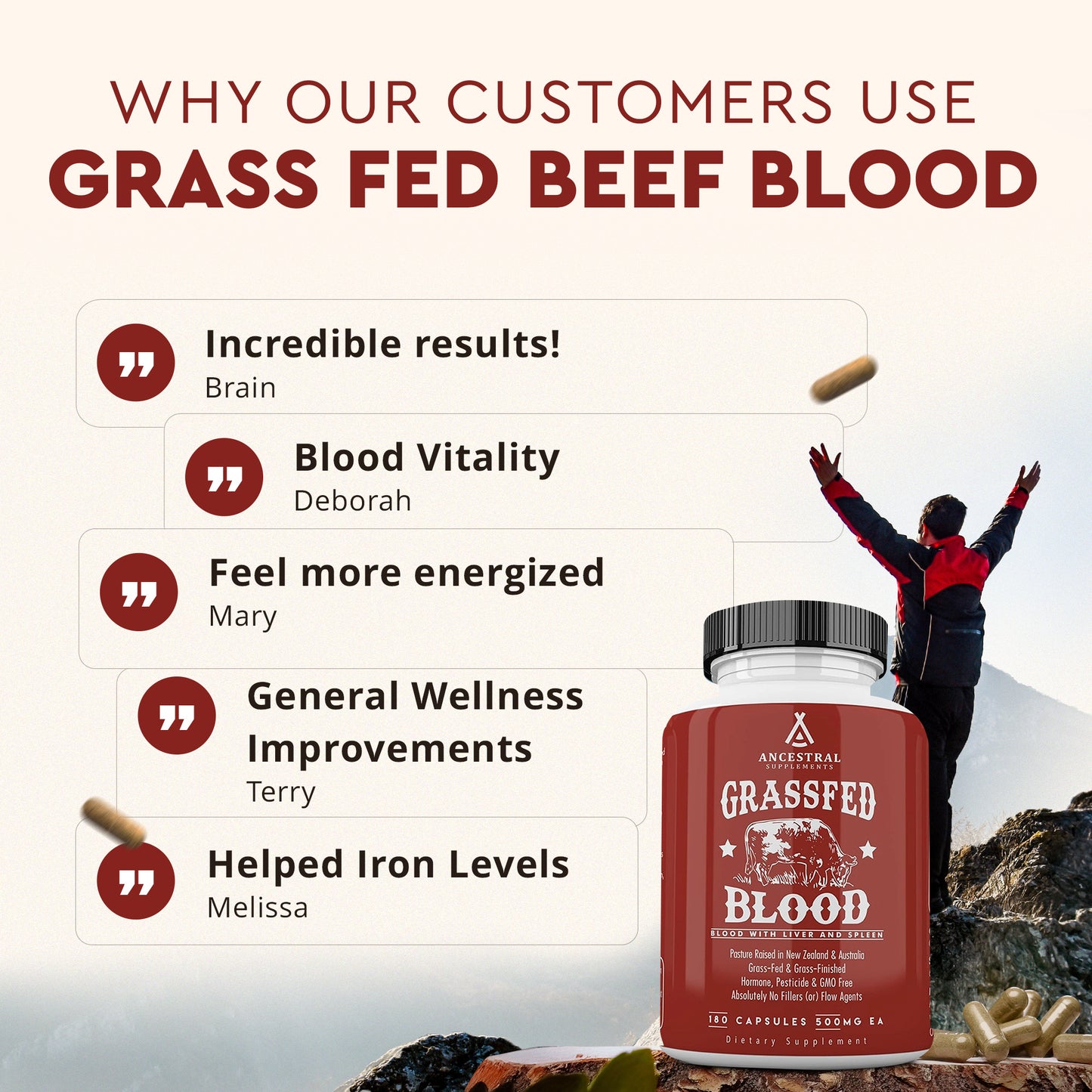
3,000,000+ Happy Customers
Grass Fed Blood Supports...
- Hemoglobin Health and Iron Status
- Endogenous iron production and robust blood building
- Red and white blood cell formation, immune function and cardiovascular health
- Methylation & Detoxification Pathways
- Energy


Grass Fed Blood Contains...
- Proteins, Peptides, Enzymes, Stem Cells and Molecular Biodirectors Specific to Blood, Liver & Spleen
- Bio-identical Vitamin D, Vitamin B12, and the Super Nutrient Coenzyme Q10 (also known as CoQ10)
- Preformed Vitamin A, Choline, Folate, Copper, Selenium
- Bio-Available Heme Iron
Grass Fed Blood Is…
- Pasture Raised In New Zealand & Australia
- Absolutely No Fillers or Flow Agents
- Third Party Tested For Purity
Restore Your Ancestral Nutrition
For most of human history, we effortlessly consumed (like-supports-like nutrition) the things we needed for strength, health, and happiness. Like the fertile ground that we once walked upon, we were a natural extension of this earth. In the modern world, we unknowingly struggle to fulfill our nutritional needs in order to support and sustain a vibrant, disease-free life. We are now part of a world where our blood health is ailing. The solution is to address the root cause with dietary, lifestyle, and behavioral choices while nourishing and supporting our blood with proven anthropological ways that are backed by modern science... this includes the use of Blood Vitality.
- New Zealand & Australia
- Ultra-Pure
- Freeze Dried
- Safety
Join 3M+ Customers
Tag us @ancestralsupplements and get a chance to be featured!
Why Our Customers
Bought This Product
To help raise my daughter's iron levels naturally
Low iron, low ferritin
Diagnosed with anemia. Do not want to take prescription iron pills.
getting ready to undergo major surgery and want to be prepared as possible.
Anemia
Iron deficiency
Explore More
-
Rated 4.7 out of 5 stars625 Reviews
FEM: Female Enhancement Mixture
Supports female hormone balance, libido, fertility, menstrual cycle regulation, anti-aging, and energy*
$54.40 $68.00 SAVE 20% -
Rated 4.8 out of 5 stars681 Reviews
MOFO: Male Optimization Formula with Grass Fed Beef Organs
Supports testosterone, libido, fertility, stamina, and performance*
$49.60 $62.00 SAVE 20% -
Rated 4.8 out of 5 stars1,159 Reviews
Grass Fed Beef Thyroid
Supports weight loss issues, muscle recovery, energy, improved mood and sleep quality*
$44.80 $56.00 SAVE 20% -
Rated 4.8 out of 5 stars1,505 Reviews
Grass Fed Beef Liver
Supports energy, detox, digestion and whole body*
$30.40 $38.00 SAVE 20%
Additional Product Information
Benefits of Grass Fed Blood
“like supports like”.
Organs and glandulars were a staple of our early ancestors' diets as the ultimate superfood, for good reason. It turns out, this nourishing tradition is backed by science...
"Radioisotope labeling studies in animals have shown conclusively that, when eaten, organs and glands selectively travel to the corresponding organs and glands in high concentrations. This research, done at the University of Scotland in Edinburgh, lends credence to the ancient practice of eating animal organs to help ensure health in one’s corresponding organs..." - Dr. Ron Schmid, ND.[3]
Our early ancestors knew this, which is why their traditional diets included the frequent and nourishing consumption of blood and like-supports-like nutrition organ meats like liver and spleen.
Grass Fed Blood - The Vessel Of Vitality
With the proper nourishment from blood, our organs and tissues can function normally to promote our optimal overall health. In the modern world, many of us are struggling with nutrient deficiencies and poor blood health… most commonly anemia. Anemia is derived from the Greek word anaimiā, meaning "without blood". Anemia is a deficiency of red blood cells and/or hemoglobin that occurs when the body doesn’t produce enough healthy red cells, has lost too many, or destroys them faster than they can be replaced.
The treatment of anemia depends upon the underlying disease… think root cause. Most medical practitioners treat anemic symptoms by simply throwing iron tablets at the problem. That said, more iron isn’t always the answer... in addition to iron, the body also needs riboflavin, folate, and vitamin B12 to produce healthy red blood cells. (Pro Tip: Liver is rich in riboflavin, folate, and B12!)
If you’re struggling with anemia, you’ll need to address it before trying to work on other health concerns. Iron is fundamental for energy production thus resolving other health issues will be virtually impossible until iron levels are increased. Any of the strategies you attempt to solve other health concerns aren't going to reach their full potential, or may not work at all, if energy production is compromised. Resolving anemia should be your first priority. That said, increasing iron levels won't sort out anemia in the long-term if there is another underlying problem. Poor spleen, liver, or thyroid health, celiacs, or other absorption issues might be at play. Once you’ve increased iron levels you’ll need to address the other underlying conditions to promote healthy long term iron status.
Beyond energy production, iron is needed to synthesize nitric oxide (a blood vessel dilator), so not only do you not have enough oxygen in your blood when anemic, you can’t deliver it as well to your tissues. The thyroid peroxidase enzyme is dependent on iron, so if you have low iron your thyroid production will suffer as well. The enzyme that produces bleach to kill pathogens, myeloperoxidase, is also iron-dependent. If you don’t have enough iron you can’t engage in that particular pattern of pathogen destruction, which means your immune system is going to fail and make you susceptible to acute infections, as well as increase the potential for chronic infections and gut dysbiosis.
I believe the answer lies in our evolutionary past... eating like our early ancestors did, consuming the whole animal, nose to tail, horns to hooves, bones to blood!!
Blood contains Vitamin B-12, Coq10, bio-identical Vitamin D, and is nature’s most concentrated source of heme iron. Blood has 5x more heme iron than Beef Spleen and10x more than Beef Liver (the most commonly used food sources of heme iron). [6] This is one of many reasons why consuming blood is so essential for blood health. That said, remember there’s more that goes into creating healthy blood… The combination of Blood, Liver, and Spleen provides all the necessary vitamins, minerals, enzymes, and cofactors to support endogenous iron production and blood building.
Other iron-rich foods such as red meat, liver, eggs, or oysters should be an essential part of your diet. There may also be some value in keeping foods rich in vitamin C such as acerola cherries, citrus or berries in your diet to help improve iron absorption (although Vitamin C is only needed to improve absorption of non-heme iron). When battling low iron, it’s important to note that high fiber foods, excessive coffee and tea consumption, calcium, and oxalates can all significantly reduce the absorption of iron from foods.
Liver - The Ultimate Superfood
Our liver participates in over 500 vital biological functions. As it relates to blood functions, our liver is responsible for the production of blood plasma proteins, the processing of hemoglobin for use of its iron content, and clearing the blood of poisonous substances. With the help of vitamin K, the liver produces proteins that are important in blood clotting. It is also one of the organs that break down old or damaged blood cells. [4]
As adults, our bone marrow is responsible for producing our blood cells, however, when in embryo, it’s our liver that produces our blood. In adults with severe anemia, the liver is able to partially restore its ability to produce blood. [5]
Grass fed liver holds the nutritional keys to blood health as it is particularly rich in vitamin A, B12, choline, folate, riboflavin and many other powerful nutrients that most people are deficient in. Grass fed Liver supports endogenous iron production, the building of blood, hemoglobin health, and liver health too. High quality desiccated beef liver supports our blood health as well as our connective tissue systems (skin, hair, gums, ligaments, tendons, etc.), energy metabolism, immune, hormone, heart, and brain health.
Whether from grass fed beef, bison, or lamb, grass fed liver is one of the most nutrient-dense, health-promoting foods you could possibly eat. Our genome has evolved with the nourishment of liver since the beginning of time… Hunters all over the world, for uncounted thousands of years, would first eat the raw livers of the animals they killed. Lions and other predatory animals will also eat the liver first.
Suggested Use (6 Capsules a Day)
Potential Issues (Detox Reaction)
A detoxification reaction is more likely to occur when starting with the full suggested serving size of 6 capsules per day. If you know that you are sensitive to supplements and/or you have an autoimmune condition, you may wish to start slow when adding this product to your current regimen. Tolerability can be greatly improved by starting with just 1 (or) 2 capsules a day and increasing by just 1 capsule every couple of days — this method may take a full two weeks to achieve the desired serving size of 6 capsules per day.
For customers that are highly sensitive to supplements and/or have an autoimmune and/or methylation SNPs, I suggest that you "play it safe" by introducing just one new capsule per week. In other words, just 1 capsule during the 1st week... 2 capsules during the 2nd week... 3 capsules during the 3rd week and so on... yes, this will take some time to reach the suggested dosages but this greatly helps to ensure tolerability of this deep nourishment so that it has a chance to do good.
Ancestral Wisdom Backed By Science [Nutrition]
Red / White Blood Cells And Platelets
Our blood is our river of life, transporting various substances that must be carried from one part of our body to another. Within our river of blood we have three different types of blood cells… red, white, and platelets. Red blood cells transport oxygen to our body's organs and tissues, white blood cells help our body fight infections, and platelets help our blood coagulate.
Together, red cells (erythrocytes) and white cells (leukocytes) are part of the full blood count, one of the most frequently requested haematology tests. Blood consists of 45% red blood cells, less than 1% white blood cells and platelets, and 55% plasma. All three types of blood cells are manufactured from stem cells deep within our bone marrow. Our blood cells are constantly being replenished since our red blood cells normally live for about 120 days, while some white blood cells only live for one to three days.
Red Blood Cells are shaped like small round discs with an indented center and flow smoothly through the blood vessels. Any irregular shape can make the cells "sticky" and unable to flow smoothly. This causes a blockage in blood flow and can lead to acute/chronic pain, infection or organ damage. Deformed cells die faster than normal blood cells—in about 10 to 20 days instead of 120 days. This causes a shortage of red blood cells.
The protein molecule of our red blood cells, hemoglobin, is what carries oxygen from the lungs to the body's tissues and returns carbon dioxide to be expelled. Embedded within the heme compound is an iron atom that is responsible for the color of our blood. The level of oxygen in our blood cells determines the brightness of the red color. Blood pumped directly from the heart is oxygen-rich and bright red, while blood carrying carbon dioxide is a much darker red and can appear deep blue or even purple when seen through the skin.
White Blood Cells are our immunity cells, always prepared for battle. They flow through our bloodstream to fight viruses, bacteria, and other foreign invaders that threaten our health. When our body is in distress and a particular area is under attack, white blood cells rush in to help destroy the harmful substance and prevent illness.
There are many different types of white blood cells that play a role in the immune response... essentially we have general responders and targeted responders.
General responders are white blood cells that recognize the antigens on the surface of bacteria, viruses, and other invaders and quickly destroy them. These cells don’t discriminate among different threats in your body; they just launch an all-out attack. This is known as a generalized immune response. Some of these cells also help pave the way for a more targeted response to specific bacteria, viruses, and other unwanted materials.
Targeted responders are white blood cells known as lymphocytes, which target invaders by producing proteins called antibodies that attack specific antigens. This process is known as a targeted or specific immune response. Each antigen that enters your body has an antibody targeted to it. Your body remembers which antibody will destroy a certain intruder, which creates a quicker immune response in the future.
Platelets are small, colorless cell fragments in our blood that form clots and stop or prevent bleeding. They are essential to surviving surgeries such as organ transplants, as well as fighting cancer, chronic diseases, and traumatic injuries. If one of your blood vessels gets damaged, it sends out signals to the platelets. Platelets then rush to the site of damage and form a clot by spreading across the broken blood vessel. When platelets get to the site of the injury, they grow sticky tentacles that help them adhere to one another. They even call in for reinforcements, by sending out chemical signals to attract more platelets.
With the help of our red cells, white cells, and platelets we are filled with oxygen, freed of carbon dioxide, protected from infections, and our wounds are tended to. Blood is the living liquid plasma complex that contains our essential workers (oxygen and carbon dioxide transport), first responders (wound healing and general immune response), and special ops, complete with detectives and snipers (targeted immune response). Consuming Grass Fed Blood provides the fundamental building blocks to support the health and production of our red & white blood cells and platelets.
Bioidentical Vitamin D
Vitamin D3 is the bioidentical form of vitamin D synthesized in the body from cholesterol, following activation by UV rays in sunlight. Regular sun exposure is excellent for maintaining healthy levels of vitamin D in the body. In the modern world sun exposure is often not sufficient for adequate vitamin D production, simply because we don’t spend enough time outside, or we live in climates where the sun doesn’t shine year-round. Getting Vitamin D from our food may be more important now, than it has ever been. Animal sources of Vitamin D3 include blood, organs, chicken and fish eggs, fatty cuts of red meat, and grass fed full fat dairy.
It is no wonder blood was so highly prized by our ancestors. Blood contains bioidentical Vitamin D! This is the Vitamin D boost that traditional cultures always had access to, when sunlight was not a readily available option.
Modern science suggests roles for vitamin D not only in bone health, but also in supporting immune, neurological, musculoskeletal, cellular, and cardiovascular health. Many health experts argue that the seasonal flu is really just a Vitamin D deficiency. By some estimates, over 90% of Americans are deficient in this critical nutrient. About 75% of people with IBS have insufficient vitamin D, and about 70% see improvement when supplementing with Vitamin D. Get your daily dose of midday sunshine and enjoy vitamin D rich foods like Grass Fed Blood, our Wild Caught Fish Eggs, pastured animal fats and raw Grass Fed dairy.
Heme Iron
Depending on whether we are male or female, we have about 2-4 grams of iron in our body. More than 95% of functional iron in the human body is in the form of heme. Iron comes in two forms: heme and non-heme. Heme iron is only found in animal food sources (muscle meat, organs, blood, etc.) Non-heme iron is found in plant foods like whole grains, nuts, seeds, legumes, and leafy greens. Heme iron is more bioavailable (absorbed more efficiently) than non-heme iron, thus the body is more likely to absorb iron from animal products than iron derived from plant foods.
Heme iron is an essential nutrient for humans. That said, there can be complications that come from too much iron because it is one of nature's most potent oxidants. Oxidants aren’t bad… they are natural by-products our cells create when they convert food into energy. They're a totally normal part of the way our bodies function and all-natural oxidants are easily tolerated. We need to be in a sweet spot where the amount of iron is just right. Processed foods fortified with iron deliver nonheme iron straight into the gastrointestinal tract where it isn’t absorbed easily and is likely to run free. It becomes free energy for pathogens and can cause oxidative stress. That’s one reason (among many!) to avoid refined grains.
Iron deficiency and iron overload are two common problems that exist side by side in the modern world. Because iron has these two roles of health and destruction, we need a sophisticated biological system to regulate how much we adsorb and what we do with it. Understanding how this system works is essential for figuring out how to solve your iron issues and how to interpret blood tests regarding iron status. If you want to get into the blood and guts of iron status read the section at the bottom of the page entitled: Iron Management
B Vitamins
In addition to iron, the body also needs riboflavin (B2), folate (B9), and Vitamin B12 to produce healthy red blood cells. Folate is essential for red blood cell formation, immune, brain and cardiovascular health. Riboflavin is essential for the absorption and correct distribution of iron. B12 helps with energy production and DNA synthesis. All B vitamins help the body metabolize fats, proteins, and carbohydrates. They also help the nervous system function properly and are necessary for a healthy liver, skin, hair, and eyes.
Riboflavin (B2)
Riboflavin helps our body absorb iron and direct it where it needs to go. In addition to providing energy for the body, riboflavin also acts as an antioxidant, helps the body convert B6 and folate into forms it can use, and is necessary for growth and cell formation. Depending on our diet, age, iron status, and hormone health, each of us will have a unique need for riboflavin. Low thyroid and adrenal hormones can impair your utilization and retention of riboflavin. Lifestyle practices that increase your need for riboflavin include: sun exposure, exercise, growth (children need more riboflavin than adults), and diet. Consuming a ketogenic diet increases riboflavin needs because burning fat requires almost twice as much riboflavin as burning carbohydrates.
If you have iron deficiency anemia that doesn't respond to an iron-rich diet and iron supplementation you may be running low on riboflavin. Most people may actually need 2-5 milligrams of riboflavin per day instead of the RDA of 1.3 mg. Those with anemia may consider 5-10mg per day. Improving your riboflavin levels can help to improve your iron absorption. Even simply improving riboflavin status (without additional iron supplementation) can improve your hemoglobin levels.
Our ancestors ate diets largely based on animal foods including nutrient-dense organ meats, rich in riboflavin. Riboflavin deficiency is a consequence of the modern diet. We no longer consume the whole animal, nose to tail. Consuming one to two servings of grass fed liver per week would do a lot to improve riboflavin status. Grass Fed Liver is the number one source of riboflavin.
Folate (B9)
Folate aids in the complete development of red blood cells, reduces levels of homocysteine in the blood, and supports nervous system function. Folate is a general term for a group of water-soluble b-vitamins, and is also known as B9. It's important to know the difference between folate and folic acid. Folic acid is a synthetic compound used in dietary supplements and food fortification, whereas folate is naturally found in whole foods.
Human exposure to folic acid was non-existent until its chemical synthesis in 1943, and was introduced as a mandatory food fortification in 1998. [7] Several studies have reported the presence of unmetabolized folic acid in the blood following the consumption of folic acid supplements or fortified foods and researchers have hypothesized that the excessive consumption of folic acid in fortified foods may be directly related to the increase in cancer rates and cognitive decline. [8] Our ancestors did not need to supplement with synthetic compounds, as they got everything they could possibly need from their ancestral diet. Not surprisingly, one of the best food sources of folate is Grass Fed Beef Liver.
B12 (cobalamin)
Vitamin B12 works synergistically with folate to synthesize DNA and red blood cells. It assists in the production of myelin, which protects your nerve cells (neurons) and regulates nerve impulse transmission. Vitamin B12 deficiency is associated with macrocytic anemia, a condition in which red blood cells are larger than normal due to impaired cell division. That said, this type of anemia is only one symptom of B12 deficiency. There are many other B12 deficiency symptoms that occur long before anemia sets in, including: cognitive decline, memory loss, brain fog, depression, cardiovascular problems, peripheral neuropathy (numbness, tingling, burning in the hands, legs and feet), impaired immune function, infertility, developmental and learning disabilities. Unfortunately, B12 deficiency is often missed by physicians and diagnosed as Alzheimer’s disease and multiple sclerosis.
A common myth among vegetarians and vegans is that it’s possible to get B12 from plant sources like seaweed, fermented soy, spirulina, and brewer’s yeast. The truth is, there are almost no vegan sources of vitamin B12. Nearly all seaweed tested has been revealed to contain vitamin B12 analogs (that is, chemically similar) called cobamides that actually block the intake of—and increase the need for—true B12. [9]
B12 is also known as Cobalamin, because it contains the trace element cobalt. Cobalamin is produced in the gut of animals and is found almost exclusively in animal foods. Some of the best sources of B12 are liver, clams, oysters, mussels, fish eggs, octopus, crab, lobster, beef, lamb, cheese and eggs. We can avoid all forms of anemia, cognitive decline, cardiovascular and immune issues simply by consuming the foods of our ancestors. Grass Fed Blood is a whole food supplement containing grass fed bovine blood, liver, and spleen that are rich in B vitamins, including B12, riboflavin, and folate which support our fundamental health, iron status, immune function, and cardiovascular health.
Vitamin A & K2
Vitamin A (retinol) is one of several fat-soluble activators necessary for the assimilation of minerals in the diet. Think of Vitamin A as the concertmaster. Its many functions include forming and maintaining healthy teeth, skin, mucous membranes, skeletal and soft tissues. It also plays a role in protein utilization. The majority of nutrition experts insist that humans can transform carotenes from fruits and vegetables to vitamin A. This is only conditionally true and is highly inefficient. Infants, diabetics, and those with poor thyroid function or zinc deficiency, (a group that makes up nearly half the US population) don’t make the conversion. And as for the rest of us… excessive consumption of alcohol, nonheme iron, prescription drugs, polyunsaturated fats, and even cold weather can hinder the conversion of carotenes to vitamin A. (4) Grass Fed Blood is a good source of preformed, bioavailable Vitamin A.
Grass Fed Blood is also rich in Vitamin K2. Dr. Weston A. Price discovered that Activator X (now known as K2), seemed to be responsible for normal bone formation, overall skeletal health, cognitive function, healthy cavity-free teeth, reproductive capabilities, and protection against arterial calcification. K2 is one of the fat-soluble activators, a super nutrient that enables our bodies to absorb and utilize all of the minerals from the foods we eat.
"It is possible to starve for minerals that are abundant in the foods eaten because they cannot be utilized without an adequate quantity of the fat-soluble activators.” - Weston A. Price.
There are two major forms of Vitamin K2 — MK-4 and MK-7. MK-4 is derived from animal sources, such as fish eggs, pastured chicken eggs, Grass Fed dairy (butterfats), meat, and in particular organ meat, such as liver. MK-7 is derived from fermented foods like sauerkraut, hard cheeses, and kefir. Vitamin K2 is an essential ingredient to include in your diet if you're interested in decalcifying your pineal gland. K2 deconstructs calcium phosphate deposits of the pineal gland and ushers the released calcium back into the bones, where it belongs.
Bone marrow, liver, and wild-caught fish eggs are all abundant in vitamin K2 (the MK-4 variety). While smashing bones and sucking out marrowfat was the hard way our ancestors obtained vitamin K, it's not that difficult to obtain marrow bones and either oven roast 3" pieces or slow cook them to make them extra delicious/nutritious... or consider getting our Pure Marrow on board!
Peptides: Splenin, Tuftsin, And Splenopentin
Based on the concept of "like supports like," consuming Grass Fed Blood may strengthen and support our own blood, liver, and spleen… this ancestral superfood is especially rich in blood, liver, and spleen-specific enzymes and peptides, such as splenin, tuftsin, splenopentin which have been shown to enhance and modulate immune health.[8] These essential nutrients all work synergistically with each other in harmony with nature, and in harmony with the wisdom of our ancestors.
Peptides are tissue-specific information molecules, which influence gene expression, start the process of protein synthesis in cells, and regulate proper cell functioning. Enzymes are biological catalysts that encourage metabolic, catabolic, and digestive processes in the body, in other words, they help cells rebuild and detoxify.
A young, healthy person's organs and glands consistently produce an optimal amount of peptides and enzymes, but as we age and are impacted by a number of different stressors ( environmental toxins, poor nutrition, stress, etc.) our organs and glands will decrease protein synthesis and no longer be able to form new peptides or enzymes. Deficiency of these nutrients results in cellular dysfunction, degenerative diseases, and accelerated aging.
One of the most effective ways to counter this deficiency is the consumption of blood, liver, and spleen-specific peptides and enzymes, by consuming their respective glandulars (Grass Fed Blood). While liver peptides and enzymes are only found within liver tissues, the same goes for spleen, and so on... it turns out mammalian-specific peptides and enzymes are bio-identical to one another. In other words, bovine peptides and enzymes are accepted by the human body as our own endogenous substances.
Consuming Grass Fed Blood supplies our bodies with peptides and enzymes it can recognize and use.
High-Quality Organs & Glands
- Should Come from An Unpolluted Geographical Region — Isolated, Healthy, Pristine Lands and Waters
- Should Come from Pasture Raised or Wild Caught Animals
- Should Come from Grass Fed Animals
- Should Come from Animals That Are Free From Added Hormones and Pesticide, Antibiotic, & GMO-Free
- Should Also Be Ultra-Pure... Absolutely No Fillers (or) Flow Agents
- Should Be Non-Defatted
- Should Be 100% Freeze Dried... Freeze Drying Preserves Heat Sensitive Biological Activity
Blood - The Vessel Of Vitality
With the proper nourishment from blood, our organs and tissues can function normally to promote our optimal overall health. In the modern world, many of us are struggling with nutrient deficiencies and poor blood health… most commonly anemia. Anemia is derived from the Greek word anaimiā, meaning "without blood". Anemia is a deficiency of red blood cells and/or hemoglobin that occurs when the body doesn’t produce enough healthy red cells, has lost too many, or destroys them faster than they can be replaced.
The treatment of anemia depends upon the underlying disease… think root cause. Most medical practitioners treat anemic symptoms by simply throwing iron tablets at the problem. That said, more iron isn’t always the answer... in addition to iron, the body also needs riboflavin, folate, and vitamin B12 to produce healthy red blood cells. (Pro Tip: Liver is rich in riboflavin, folate, and B12!)
If you’re struggling with anemia, you’ll need to address it before trying to work on other health concerns. Iron is fundamental for energy production thus resolving other health issues will be virtually impossible until iron levels are increased. Any of the strategies you attempt to solve other health concerns aren't going to reach their full potential, or may not work at all, if energy production is compromised. Resolving anemia should be your first priority. That said, increasing iron levels won't sort out anemia in the long-term if there is another underlying problem. Poor spleen, liver, or thyroid health, celiacs, or other absorption issues might be at play. Once you’ve increased iron levels you’ll need to address the other underlying conditions to promote healthy long-term iron status.
Beyond energy production, iron is needed to synthesize nitric oxide (a blood vessel dilator), so not only do you not have enough oxygen in your blood when anemic, you can’t deliver it as well to your tissues. The thyroid peroxidase enzyme is dependent on iron, so if you have low iron your thyroid production will suffer as well. The enzyme that produces bleach to kill pathogens, myeloperoxidase, is also iron-dependent. If you don’t have enough iron you can’t engage in that particular pattern of pathogen destruction, which means your immune system is going to fail and make you susceptible to acute infections, as well as increase the potential for chronic infections and gut dysbiosis.
I believe the answer lies in our evolutionary past... eating like our early ancestors did, consuming the whole animal, nose to tail, horns to hooves, bones to blood!!
Blood contains Vitamin B-12, Coq10, bio-identical Vitamin D, and is nature’s most concentrated source of heme iron. Blood has 5x more heme iron than Beef Spleen and10x more than Beef Liver (the most commonly used food sources of heme iron). [6] This is one of many reasons why consuming blood is so essential for blood health. That said, remember there’s more that goes into creating healthy blood… The combination of Blood, Liver, and Spleen provides all the necessary vitamins, minerals, enzymes, and cofactors to support endogenous iron production and blood building.
Other iron-rich foods such as red meat, liver, eggs, or oysters should be an essential part of your diet. There may also be some value in keeping foods rich in vitamin C such as acerola cherries, citrus or berries in your diet to help improve iron absorption (although Vitamin C is only needed to improve absorption of non-heme iron). When battling low iron, it’s important to note that high fiber foods, excessive coffee and tea consumption, calcium, and oxalates can all significantly reduce the absorption of iron from foods.
Lifestyle Practices For Optimizing Blood Health
Include Colostrum and Raw Dairy in Your Diet- Lactoferrin found in milk, colostrum, and other dairy products help control the absorption and distribution of iron in the gastrointestinal tract. Latoferrin directs iron towards probiotic bacteria and away from pathogenic bacteria. Lactoferrin has been shown to improve anemia more effectively than some iron supplements! Remember not to consume any dairy/calcium within a couple of hours of your iron-rich foods.
Improve Your Circulation- Our blood needs to be circulating regularly, recycling and regenerating itself to remain healthy. The best way to improve your circulation is to remain active throughout the day. If you’re a professional sitter, consider a standing desk instead. Walk often… go for a 10-minute walk 3 times a day in the woods with your dog to get your blood flowing.
Iron Management
The 4 key players in the system that regulate how much iron we absorb and what we do with it are: Ferritin, Transferrin, Hepcidin, & HFE.
Ferritin levels are elevated when someone has liver damage, hemochromatosis, neurodegenerative diseases, iron overload, and inflammation. That might suggest ferritin is a bad guy, but that would be a false conclusion. Ferritin is unambiguously a good guy. The purpose of ferritin is to sequester iron into long-term storage which prevents oxidative damage. This also prevents pathogenic bacteria from accessing free iron, which can allow them to grow and multiply (free iron is like free energy for pathogens).
While ferritin is our long-term storage, transferrin is our short-term storage. Ferritin is like your savings account, while your transferrin is like your debit card. With transferrin, it’s easy to make deposits and easy to withdraw on demand. It’s like there are transferrin ATMs in every tissue in every cell membrane… We can look at our transferrin levels to give us a sense of how much iron we have going in and out on a day-to-day basis.
When it comes to how our body responds to iron, hepcidin is the master coordinator. When we have too much iron in the system, hepcidin is going to respond by down-regulating iron adsorption and then direct free iron into ferritin. Hepcidin is not only going to respond to iron status itself, it's also going to respond to things that would make iron dangerous. For example, if you have an infection, the inflammation is going to drive up hepcidin. Hepcidin is going to coordinate this response to say, “In this inflammatory state it would be dangerous to have too much iron because it would feed the growth of those pathogens, so we're going to adsorb less iron from food, then we're going to sequester the free iron that we already have into ferritin to prevent pathogens from having access to it.”
The HFE gene helps transferrin communicate with hepcidin about the amount of iron available in the system. HFE is the primary gene that can be mutated in someone with hemochromatosis. A mutated HFE gene will tell hepcidin there is more transferrin than there actually is, which leads to high ferritin.
Our understanding of how this system works shifts our understanding of how we should view blood testing. Remember, there are two sides to this… iron overload and anemia. Across the board, the players in this system are the same and the same set of tests are to be used. The most important markers for iron status are a complete blood count and a full iron panel.
In anemia, it is most important to look at the state and shape of the blood cells and get a complete blood count. Anemia by definition is a deficiency in properly functioning red blood cells, whether it's that you don’t have enough red blood cells or that you don’t have enough hemoglobin in those red cells or some alteration to their structure and size that causes them to work improperly.
Across the board, you want transferrin saturation to be between 30-40%. Ferritin is going to have a wider range… somewhere between 60-140ng/ml. Measuring Ferritin is complicated and in my opinion, should not be the focus of addressing iron health. Transferrin is a better indicator of optimal iron status. Monitoring transferrin is like putting a smoke detector in your house while monitoring ferritin is like waiting for a text from the fireman (who arrived late) to put out the fire in your house.
Iron & Ferritin Supplements
Many people struggle with side effects from traditional iron supplements. Someone with low iron may simply start adding as much iron as possible to their system… generally from non-heme iron sources, and then they struggle with iron overload. Excess intake of isolated non-heme iron can cause constipation, impair the uptake of essential trace minerals, and contribute to a higher state of oxidative stress.
Be careful if you're using NRF2 supplements to increase ferritin. There are many supplements on the market that are designed to protect you against oxidative stress by stimulating a hermetic response from NRF2. (Things like milk thistle, sulforaphane, green tea extract, Protandim.)
These supplements are touted to “help you” by tricking your body into thinking that there is oxidative stress. In reality, they cause a small amount of oxidative stress which causes a disproportionate increase in your defenses. Since one of your defenses is ferritin, that means that if your taking those supplements, they can hurt your ability to resolve anemia because you are eating iron, but those supplements are causing your iron to get directed into ferritin instead of hemoglobin and the other important needs that you have for that iron.
Although I own a supplement company, I do not believe in supplements. Technically, our products are just... food. Our supplements are a whole-food, natural source of vitamins, nutrients, cofactors, and enzymes that interact in harmony with nature as opposed to concentrated doses (and isolated compounds) that are manufactured. Our ancestors never would have had access to these supplements, nor did they need them. I suggest getting heme iron from whole food sources, like a nice juicy steak, liver pate, or our Grass Fed Blood.
Grass Fed Blood is particularly rich in heme iron compared to other organs and glands. The amount of heme iron that one would expect in one dose of Grass Fed Blood (6 capsules) is approximately 24.4 mg. Grass Fed Blood is the perfect whole food supplement for someone with low iron. That said, if you have too much iron you might consider Beef Liver, the amount of heme iron that one would expect one serving size of Beef Liver is approximately 2 mg. A moderate amount of liver will almost always confer more benefit than potential harm from too much iron. Nutrition authority Chris Masterjohn, PhD has a great podcast on this topic entitled "Why You Need to Manage Your Iron Status and How to Do It."
The take-home message is that organs and glands are too nourishing, and too necessary to our biology, to eliminate them from our diets... instead, eat the liver (and other organs) and reduce other iron-rich foods here and there if you are "concerned" with iron overload. He even goes so far as to suggest combining some dairy (or calcium) with the liver to lessen the bio-availability of the iron if too much iron is a concern for an individual. Other natural iron chelators (to lessen bio-availability) are quercetin and curcumin. Donating blood can also be a very effective strategy for managing iron overload.
If you're still concerned about iron overload, I'd suggest listening to his podcast. Here is the full link info… https://chrismasterjohnphd.substack.com/p/032-why-you-need-to-manage-your-iron Or you can do a Google search for “Chris Masterjohn PhD — Why You Need To Manage Your Iron Status.” You can skip right to the good stuff by fast forwarding to .
- Choosing a selection results in a full page refresh.
- Opens in a new window.
Register to receive a notification when this item comes back in stock.

